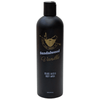Listen up, baby face.
Growing a beard isn’t a race.
And I’m not a rapper so that’s the end of that.
We’ll start with the good news.
In time, hair WILL - in most cases - sprout from your face. The bad news is that only your genetics will determine whether that facial hair is worth keeping or not.

Most of us have been there - other lads around you are either starting to grow at least a moustache - maybe a bit of chin fur - or they’re complaining about how they had to shave again this morning.
And you’re sat there thinking “what’s wrong with me? Why am I still getting ID’d for energy drinks? When will MY beard start to blossom?”.
Beard Growth Age: Full beard growth typically occurs in the early 20s, but some men may need to wait until their 30s due to genetic and hormonal factors.
Stages of Beard Growth: Beard growth has 5 stages: stubble, growth, beard time, tidy-up, and maximum length, each with varying timeframes and maintenance needs.
Factors Influencing Growth: Genetics, hormones, age, ethnicity, and lifestyle all play significant roles in how quickly and fully a beard grows.
Genetics and Ethnicity: Your genetic background and ethnicity can significantly affect beard growth, with some groups naturally having fuller beards than others.
At what age does a beard grow fully?
While your beard may begin to grow as soon as you hit puberty, you shouldn’t expect it to grow fully until much later than that. Most men will have a full beard by their early 20s, but some may need to wait until they hit 30 to reach full beard growth.
Puberty might initiate the facial hair growing process, but how fast and thick your beard grows will depend on factors that we’ll discuss below, including genetics and hormone levels.
There’s no need to panic, though, as having to wait until the third decade of your life would certainly be an unlikely and unlucky situation - just be prepared for the worst and you can only be pleasantly surprised, right?

You’ll probably have to wait until you’re at least 18 before the beard is worthy of sending through to our Instagram DMs - and, if you’ve drawn the short straw genetics-wise, you may have to wait until your 20s. Or 30s. Or, unfortunately, never.
But AGAIN, there’s no rush. Only time will tell. Just enjoy your youth while you can.
The 5 Stages Of Beard Growth
Once the right amount of time has passed and a particular threshold of testosterone production has been reached, the process begins.
There are 5 stages to this beard-growing process, and it goes a little something like this:
1. Stubble
This phase lasts around seven days. You should be able to predict how fast or slowly your facial hair will grow based on how much stubble is left at the end of the week.
2. Growth
The next two weeks make up this stage. You'll be able to see whether there will be any patchiness or redundant hair follicles by looking at the pattern of hair development.
If you’re noticing patchiness in your beard hair, it could be worth trying out a beard roller to encourage blood flow and growth in those patchy areas.
3. Beard Time
You should have a noticeable facial hair growth by the conclusion of step three, which takes an additional two weeks. A full beard may not be in your future if you still have little facial hair at this point.
Take a look in the mirror. That’s a beard on your face.
4. Tidy-Up Time
Your second month of beard growth is well underway. It will probably be time to see a barber to get it cut and given the desired shape.
Unless unruly is your attitude and general state of mind.
5. Maximum Length
Beards don’t always just keep growing forever.
You should see reduced hair growth after two months. You may now choose if you want to commit to the appearance and maintenance of a full beard.
It’s not easy for us to grow beards, but you’ve mastered it.
Which Factors Affect Beard Growth?
As we've previously indicated, the preceding steps may not start until you're in your 20s or they might never happen at all.

Your beard may grow in more quickly or more slowly, or may not grow in all the locations you want depending on your race, age, genetics, hormones, and other factors, including a number of medical issues.
Any of the following 5 variables may be at play if it looks like your beard is taking a while to fill out.
1. Genetics
The degree to which you may develop a full beard is heavily influenced by your direct ancestry. Similar to this, your DNA also determines your hair's texture, if you'll become bald, and other things.
Look to your male ancestors for hints on the direction your beard hair may take. Hair patterns do seem to be inherited, however, there is no guarantee that a father with a long beard would produce a kid who can pull it off too.
2. Hormones
Growing a beard may be more challenging for those with low testosterone levels. To assist in battling low testosterone levels, discuss with your doctor if you should attempt testosterone treatment or take supplements.
3. Age
Age has been brought up a few times as it certainly affects your beardy hopes and dreams . It’s worth asking your old man when he was first able to start growing a beard. Your grandad, too.
Some children seem to develop facial hair much before you would ever contemplate wanting to. In third grade, one of the students at our school had a moustache. He was an exception, and that was abnormal.

Normal beard growth may begin at the age of 18, but for many guys, that period may not come until they are 30. Therefore, it could not be your time if you're not seeing the desired beard development.
4. Ethnicity
Middle-Eastern and Mediterranean men seem to all have flawless, thicker beards than most other ethnicities. Every hair follicle is pulling its weight and those men just absolutely know it don’t they.
White men and Chinese men, for example, don’t seem to have as much luck with facial hair.
Ethnicity certainly plays a part in how well, and when, you can grow a beard, so this is another factor that should be taken into account when the follicles don’t seem to be doing their job.
5. Lifestyle
Many lifestyle factors certainly affect your beard growth, such as getting a healthy diet, regular exercise, hydration levels, stress levels and hygiene.
These factors control your blood flow, testosterone levels and more, which directly impact hair growth - that’s both beard hair and scalp hair - so if your dome is looking worse for wear, it’s all the more reason to pick up some more healthy habits.
While stress levels can be difficult to control, each of those other factors can be controlled more easily, so make sure you do to encourage full beard growth.
Be Patient
The average beard growth rate, when your beard does finally decide to get to work, is around 0.3 - 0.5mm every 24 hours.
We can’t stress enough how important it is that you don’t stress about your beard growth or when it is finally going to come in or fill out.

Enjoy the baby-faced life for now, as the second you begin having to pay adult ticket prices on public transport, can’t play in the ball-pit anymore, have to pay taxes, have t.. You know what just good luck to you.
And when hair growth finally kicks in and you have a nice thick beard, make sure you look after it with beard oil, beard wash and other beard grooming products to ensure you have healthy hair follicles and therefore a healthy beard.


